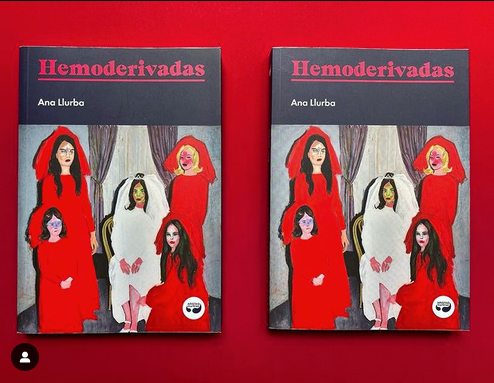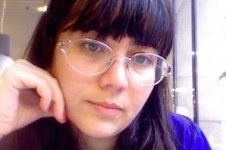Search
To search for an exact match, type the word or phrase you want in quotation marks.
A*DESK has been offering since 2002 contents about criticism and contemporary art. A*DESK has become consolidated thanks to all those who have believed in the project, all those who have followed us, debating, participating and collaborating. Many people have collaborated with A*DESK, and continue to do so. Their efforts, knowledge and belief in the project are what make it grow internationally. At A*DESK we have also generated work for over one hundred professionals in culture, from small collaborations with reviews and classes, to more prolonged and intense collaborations.
At A*DESK we believe in the need for free and universal access to culture and knowledge. We want to carry on being independent, remaining open to more ideas and opinions. If you believe in A*DESK, we need your backing to be able to continue. You can now participate in the project by supporting it. You can choose how much you want to contribute to the project.
You can decide how much you want to bring to the project.

I am, among many other things, a fiction writer. In my latest novel, Hemoderivadas I imagined the possible trajectory of Pandora Ferreira-Bisset, an invented, apocryphal artist who has worked with blood and bodies. Her work and her imaginary life gave rise to a satire on some trends in contemporary art in order to expose the absurdities and dangers inherent in misogyny, feminine essentialism and transphobia.
This was possible thanks to the generous invitation of different artists and curators, as well as the talks with and support of friends, who encouraged me to spend some very pleasant time in that liminal zone where the literary imagination coexists with the real, the true and the historical. It was this same playful drive that motivated me to ask Emilia Casiva, Anaïs Senli, Verónica Lehner and Raisa Maudit how they relate to, transmute and challenge fiction as the reverse and obverse of art.
This is how I found out that parody and humor in the work of Sofia Torres Kosiba give life to a fictitious patrician affiliation. Just like Emilia Casiva’s gaze in Family Game: Between Speculative Imagination and Historical Hallucination, where the distance between the critic’s contemplation of the work implodes. Both become a single voice, while one unleashes “the real,” that is, the invented family, apocryphal genealogy, naked aspiration. As Casiva states:
“The performing arts involve inventions of reality. Art is no mere illusion, however, but rather the material elaboration of a fantasy placed in the world.”
Who wouldn’t want to reinvent themselves over and over again through art and fiction? In this unleased will, the family, that atavistic and primitive institution, is revealed as an invented, made-up, reappropriated entity, an imaginary place to test elastic forms of a community of meaning that expand beyond biological, genetic or anthropocentric determinisms.
That is the path that Anaïs Senli takes to investigate the liquidity that configures us and unites us in an indivisible mass, a continuum of fluids, the primary community at the origin of life on the dust of this planet. We are water and we are life, we are indivisible matter, as indicated by La Línea Fusca. Like the equator, that dark, vertical line that emerges on a woman’s abdomen around the second trimester of pregnancy and which becomes a horizontal line, the geographic reference in the midst of hormonal turmoil. In that undulating movement, calm but incisive, spurred on by doubts and questions that transcend human exceptionalism, Senli articulates her personal testimony about motherhood:
“All water on Earth is extraterrestrial, it is the second most common molecule in the Universe. Our solar system is drowning in amniotic fluid. Is the Milky Way a stellar womb that gestates new types of plural life? Your existence shakes my view of the word ‘I.’ But did you know what I meant when I said ‘I’ before you? Am I really an independent and autonomous being as I had been told? Or am I rather an ecosystem that radically depends on everyone and everything around me?”
From the performing arts as “inventions of reality” in Sofía Torres Kosiba, in the voice of her double, compressed and paronomasic, Emilia Casiva, to self-science fiction that gives meaning to motherhood in Anaïs Senli, other genres, other resources, other devices and artifacts sponsor this playful place where art and fiction mutate, imitate and transform.
A space of play where water, rocks, acrylic, ceramic, lava, and blood all coexist, the “vibrant” matter in the works of artists Verónica Lehner and Raisa Maudit.
In these biotic and abiotic elements, a state of movement or transformation occurs according to Verónica Lehner and her Ejercicios de complicidad o la obstinación de lo mutable (Exercises of Complicity or The Obstinacy of the Mutable). This is how we witness a fragmentary exploration that provokes an estrangement, a destabilization, in the telling words of Jane Bennett (2022):
“I will return again and again to the figures of ‘life’ and ‘matter,’ destabilizing them until they begin to seem strange, more or less like the way an ordinary word can become a strange and meaningless sound when repeated often. In the space opened up by this estrangement, a vital materiality can begin to take shape.”
In this way, a mystery unfolds before a childish, naive complicity, in which animated objects are no longer just passive things. Beyond animism, pantheism and the limits of anthropological categories, and beyond the speculation typical of exobiology, Verónica Lehner shares her surprise and admiration of these phenomena:
“Matter is presented as something unfinished, something that remains in a continuous process without moving towards a final form, something that remains in a perpetual state of becoming something.”
Ekphrasis, in its original etymological sense, meant “to give life to an inanimate object,” and today it expresses the verbal or written representation of a visual image. However, in Del Transformismo a la Transformación: la Furia, la Sangre y la Lava (From Transformism to Transformation: Fury, Blood and Lava) by Raisa Maudit, that figure of speech embodies a dark mythological origin. Lost among zombie linguistic taxonomies that are reborn and mutate between words and things, this resource acquires a new vitality, giving voice to the fury, lava and blood that challenge and intimidate us with their omnipresence and continuous mutation:
“To you who read this without knowing what you were reading, you were already warned: here is the meaning of everything we have been and will be, of everything we do on all planes. Many unmentioned processes and references are hidden in these lines, for here there is wisdom and intelligence to perdition, from philosophy, science, theology, music, literature, art, and above all, a Transformism that has become Transformation. It’s up to you to decode it. If before you feared us, now truly fear us.”
From invented genealogy to science fiction and autobiographical speculation, passing through new materialisms and new ontologies, in these authors and artists a desire for multiplicity emerges. A mediumistic capacity to embody questions beyond the self or as a denial of it. As the writer Betina Gonzalez (2021) states about the secret heart of writing and the liberating force of imagination (and, I would add, of art):
“In all fiction writing there is a denial of the self or at least a withdrawal. To write is to leave oneself, to lose your sense of place. Exclude yourself. The inspiration to invent is to become others, the ambition to be multiple.”
Within this “displacement” to create the other, although not necessarily human or familiar, is the playful drive for multiplicity on which the rules of the game of these four voices are based. It is this ambition to be multiple that beats in the texts of Emilia Casiva, Anaïs Senli, Verónica Lehner and Raisa Maudit, and which cradles infinite, mutable dialogues, in constant transition, between art and fiction.
Cited bibliography:
Bennett, Jane (2022). Vibrant Matter: A Political Ecology of Things.
Gonzalez, Betina (2021). La obligación de ser genial (The Obligation to be Genial). Editorial Gog and Magog. Buenos Aires, Argentina.

Ana is fascinated to dive into books and movies, to approach with caution those tentacles that lie in the depths and to return to count what she has seen. She has published “Este es el momento exacto en que el tiempo empieza a correr” (Premio Antonio Colinas de Poesía Joven), the novels “La puerta del cielo” and “Hemoderivadas”, “Constelaciones familiares” (short stories, Premio Celsius Semana Negra de Gijón) and “Érase otra vez. Contemporary fairy tales” (essays). She currently lives and works between Berlin and El Paso, Texas, where she is a Bilingual MFA Fellow in Creative Writing at UTEP. Some of her texts have been translated into Portuguese, Italian, Polish, Lithuanian, German and English.
"A desk is a dangerous place from which to watch the world" (John Le Carré)